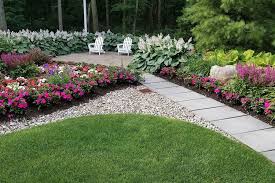Reasons To Use Native Plants in Your Landscape Design

Native plants are plants that grow naturally in a specific area without the help of humans. Most of these plants have developed characteristics that enable them to grow optimally in the local climate, requiring less gardening work. They normally are less demanding in terms of maintenance, water, and fertilizers as compared to exotic plants. Landscapers can incorporate native plants into landscape designs to produce diverse and ecological designs specific to your region. Here are the reasons to use native plants in your landscape design:
Ecological Benefits
Native plants have created mutual relationships with the other species in the environment to foster bio-diversity. When you’re using native plants, you are supporting these ecological links. They offer food to native insects, birds, and other animals, which supports the overall health of your local ecosystem. Once landscapers add these plants to your property, the carbon content in the air reduces.
Low Maintenance
Once planted, indigenous plants grow naturally without much need for constant watering, fertilization, or trimming. This can eliminate the use of chemical pesticides and fertilizers, cutting the expenses of maintaining the yard. Local diseases and pests typically have less of an effect on native plants, making intervention unnecessary in most cases. This makes native landscaping an ideal solution for many homeowners who don’t wish to dedicate much time to gardening.
Year-Round Interest
A common misconception that people have about local plants, is that native plant landscapes are not visually appealing all year round. Depending on the plants you choose, you can create a landscape composition that will be appealing all year round. Some native plants have colored leaves, flowers, and fruits, which change color throughout the seasons, making your landscape colorful and constantly evolving. Spring could have bright wildflowers; summer may exhibit rich green leaves; fall presents great foliage colors. In winter, the plants could display bark seeds or berries.
Reduce Pollution
Native plants have large root systems that help clean the water by filtering it through the soil, improving groundwater quality. These plants also absorb air pollutants and sequester carbon dioxide, improving the air quality of the area. Native plants require little to no chemical inputs, such as fertilizers and pesticides, preventing the pollution of water bodies through agricultural drainage. These plants are useful in preventing the occurrence of soil erosion and the pollution of water systems with silt.
Preserve Regional Identity
Native plants foster regional diversity and endemism, making particular regions unique due to their natural, unspoiled attractions. They can also contribute to the creation of regional art and design. Adding native plants to your landscape can also aid in the protection of threatened or endangered local plants.
Working With Landscapers
Native plants support local fauna, pollinators, birds, and other beneficial insects that increase the biological spectrum of your region. These plants often demand comparatively fewer irrigations, feeds, and pesticides as compared to exotic species. Professional landscapers can guarantee correct installation, improving the probability of the plants’ healthy growth within the yard. Contact a professional landscaping company to get started.





